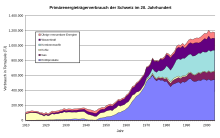Energy consumption in Switzerland
The energy consumption in Switzerland was approximately 854 petajoules (PJ) in the year 2016th
Primary energy source
In Switzerland the following primary energy sources are used for energy :
- oil
- natural gas
- coal
- uranium
- Hydropower
- Solar energy
- Wind energy
- Biogas energy
- Garbage and industrial waste
- Ambient heat
Consumption development
industrialization
Since the industrial revolution in the century before last, energy has played an increasingly important role in economic and social development. During the industrialization was coal is of the utmost importance. The importance of wood decreased sharply.
First and Second World War
Coal became scarce during the First World War . Local coal was mined at that time, but its deposits were modest. It was similar in World War II . In both wars, total energy consumption fell . The local energy sources such as water and wood became more important.
In the inter-war period, oil was used, which in the Second World War almost returned to zero due to the impossibility of importing it . Just before the Second World War, coal reached the peak of its consumption career.
Post-war period until the oil crisis
After the Second World War, oil consumption experienced an upswing. This also increased the total energy consumption enormously. This can be explained with the increasing general prosperity and with the population growth.
From 1969, nuclear energy was used commercially. Originally, coal and oil-thermal power plants were also to be built. However, these ideas met with fierce opposition for cost and environmental reasons.
In the 1970s, oil became the absolutely dominant source of energy. Since then, oil consumption has decreased slightly, but its share of total energy consumption has fallen sharply. During this time the share of nuclear fuels rose to approx. 10% primary energy.
Around the same time, natural gas began to be used. Up until then, gases had also been used as an energy source, such as town gas . However, these gases were secondary energy sources because they were made from coal, oil or wood.
In 1973 and 1979 there were two oil crises . The oil got more expensive. This resulted in a more efficient use of energy, which is still having an effect today.
Oil crisis to this day
During the oil crisis, the strong dependence on oil was recognized. That is why a trend towards alternative energies began . For example, electricity and heat were also produced from waste incineration and sewage treatment plants. Since then, there has also been a certain diversification through the increased use of natural gas as a substitute for oil heating. Today the main focus is on saving energy and using renewable energies such as solar energy , wind energy or biomass , although their share of total consumption is low.
After the nuclear disaster in Fukushima , it was decided to phase out nuclear energy .
See also
Web links
- Overall energy statistics , Federal Office of Energy
- energie-schweiz.ch Everything about Swiss energy
Individual evidence
- ↑ Federal Office of Energy SFOE - overall energy statistics ( Memento of the original from December 28, 2014 in the Internet Archive ) Info: The archive link was inserted automatically and has not yet been checked. Please check the original and archive link according to the instructions and then remove this notice. , accessed on January 14, 2018
